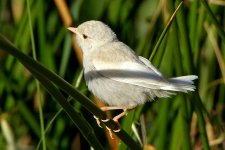To keep on track with this bird I would explain it (probably very poorly) like this. Albinism is an abnormality found in some plants, animals and birds. Except in plants (caused by a lack of chlorophyll), albinism is caused by the absence of natural pigment in, this case, feathers. In true albinos, as was with this bird, the eyes are peculiarly affected; the iris is pale rose colour and the pupil bright red, owing to the lack of pigmentum nigrum, the colouring matter of the eye membrane. The condition is congenital and should not be confused with any seasonal variation. Many ‘white’ occurring birds are not true albinos, because normal pigment is retained in the eyes, beaks and feet, only the feathers are deficient in pigment. So not only is ‘our bird’ a true albino, but is also extremely rare. Hope this is helpful Steve? I did explain with my above words the condition of Albinism as best as I could in the article.
Peter





